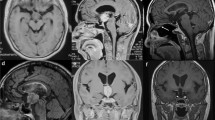Abstract
Tumors in the III ventricle were totally removed in three children using a route through the lamina terminalis. The cases are discussed on the basis of computed tomography and intraoperative findings. It seems that tumors 4×2 cm in size can be successfully removed via this relatively small opening if the neuroradiological findings and the probable histology (craniopharyngioma) provide secure evidence that the tumor site and growth matrix are located in the frontal and lower portion of the III ventricle. Besides the advantage of requiring no transparenchymal access, this quick axial (orthograde) approach exerts no pressure on the hypothalamus, a complication which cannot always be avoided with the transcallosal route or the route through the foramen of Monro. Furthermore, the immediate location of the tumor behind the usually protruding lamina terminalis permits a rapid operation without exploratory characteristics. The distance between the brain surface and the tumor with this procedure is 0 cm; however, it can be up to 9 cm, depending on the age of the patient, with other approaches.
Similar content being viewed by others
References
Appuzo MLJ, Chikovani OK, Gott PS, Teng EL, Zee CS, Giannotta SL, Weiss MH (1982) Transcallosal, interfornical approaches for lesions affecting the third ventricle: surgical considerations and consequences. Neurosurgery 10:547–554
Appuzo MLJ (1988) Transcallosal interfornicial exposure of lesions of the third ventricle. In: Schmidek HH, Sweet (eds) Operative neurosurgical techniques, vol 1, 2nd edn. Grune & Stratton, New York, pp 389–395
Baskin DS, Wilson CB (1986) Surgical management of craniopharyngiomas. A review of 74 cases. J Neurosurg 65:22–27
Bollati A, Giunta F, Lenzi A (1974) Third ventricle intrinsic craniopharyngioma. Case report. J Neurosurg Sci 18:216–219
Carmel PW, Antunes JL, Chang CH (1982) Craniopharyngiomas in children. Neurosurgery 11:382–389
Cashion EL, Young JM (1971) Intraventricular craniopharyngioma. Report of two cases. J Neurosurg 34:84–87
Cavazutti V, Fischer EG, Welch K, Belli JA, Winston KR (1983) Neurological and psychophysiological sequela following different treatments of craniopharyngioma in children. J Neurosurg 59:409–417
Erdheim J (1904) Über Hypophysenanhangsgeschwülste und Cholesteatome. Sitzungsber Königl Akad Wiss 113:537–542
Fischer EG, Welch K, Belli JA, Wallman J, Shillito JJ, Winston KR, Cassady R (1985) Treatment of craniopharyngiomas in children. J Neurosurg 62:496–501
Grover WD, Rorke LB (1968) Invasive craniopharyngioma. J Neurol Neurosurg Psychiatry 31:580–582
Hoff JT, Patterson RH (1972) Craniopharyngiomas in children and adults. J Neurosurg 36:299–302
Hoffman HJ, Hendrick EB, Humphreys RP (1977) Management of craniopharyngioma in children. J Neurosurg 47:218–227
Koos WT, Spetzler RF, Pendl G, Perneczky A, Lang J (1985) Color atlas of microneurosurgery. Thieme, Stuttgart New York, pp 56–59, 48–65
Lavyne MH, Patterson RH (1983) Subchoroidal trans-velum interpositum approach to mid-third ventricular tumors. Neurosurgery 12:86–94
Luschka H (1860) Der Hirnanhang und die Striessdrüse des Menschen. Von Georg, Reimer Berlin
Northfield DWC (1973) The surgery of the central nervous system. Blackwell Scientific, Oxford London Edinburgh Melbourne
Patterson RH, Danylevich A (1980) Surgical removal of craniopharyngiomas by a transcranial approach through the lamina terminalis and sphenoid sinus. Neurosurgery 7:111–114
Rush JL, Kuske JA, De Feo DR (1975) Intraventricular craniopharyngioma. Neurology 25:1094–1096
Russell DS, Rubinstein LJ (1971) Pathology of tumours of the nervous system, 3rd edn. Williams and Wilkins, Baltimore
Seeger W (1980) Microsurgery of the brain, vol 1. Springer, Wien New York, pp 286–363
Seeger W (1986) Planning strategies of intracranial microsurgery. Springer, Wien New York, pp 222–277, 270–335
Solarski A (1978) Craniopharyngioma in the pineal gland. Arch Pathol Lab Med 102:490–493
Sweet WH (1988) Craniopharyngiomas (with a note on Rathke's cleft or epithelial cysts and on suprasellar cysts). In: Schmidek HH, Sweet (eds) Operative neurosurgical techniques, vol 1, 2nd edn. Grune & Stratton, New York, pp 349–379
Symon L, Sprich W (1985) Radical excision of craniopharyngioma. J Neurosurg 62:174–181
Zenker FA (1857) Enorme Zystenbildung im Gehirn, vom Hirnanhang ausgehend. Arch Pathol Anat Physiol Klin Med 2:454–466
Author information
Authors and Affiliations
Rights and permissions
About this article
Cite this article
Klein, H.J., Rath, S.A. Removal of tumors in the III ventricle using the lamina terminalis approach. Child's Nerv Syst 5, 144–147 (1989). https://doi.org/10.1007/BF00272115
Received:
Issue Date:
DOI: https://doi.org/10.1007/BF00272115




